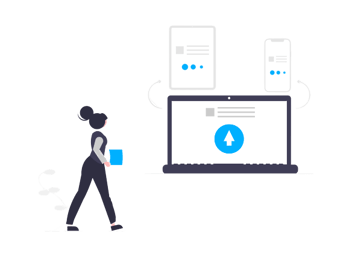Good tools to collect live customer feedback
Digital technology has advanced a lot in the past few years and collecting customer feedback has never been easier. One of the best advancements is the ability to collect feedback in real time. When you ask for feedback immediately after an interaction with a customer, they’re far more likely to respond and share meaningful insights.
Don’t get us wrong, traditional feedback methods still have their place. But if you want to take your customer feedback to the next level, you need to tap into these live feedback tools.
Live customer feedback
With real-time feedback tools, brands can meet customers where they are at the most opportune time. The most common examples of these tools include chatbots, live chat, QR codes, and automated survey links, each of which can be used to target customers immediately after an exchange. On the other hand, traditional methods like emails, contact forms, customer reviews, and social media are sent after the event and therefore don’t capture the same valuable data.
The value of real-time customer feedback
Live feedback is more proactive, relevant, and efficient. For that reason, customers take the time to respond thoughtfully and honestly, giving brands the actionable insights they need. For example, a company can connect with a customer as soon as they buy a product online, ask them how the purchase process was, and whether there was anything they could have done differently. This way the customer is in the right mindset to respond and anything they want to share is front of mind.
Benefits of live customer feedback include:
- Responses are more meaningful because they are fresh from the moment.
- Customers are more likely to respond.
- Gives insight into customer behaviour.
- Fewer delays between a complaint and the corresponding resolution.
- Customers have an appropriate outlet for their worst frustrations, other than public reviews.
With real-time data collection, your business will be able to address customer concerns as they arise. This way, customers aren’t left feeling frustrated or ignored and there isn’t a long delay between the initial complaint and subsequent response. This makes customers feel heard, acknowledged, and valued, knowing the company is attentive to their perspective. This fosters a positive relationship between the brand and the user, building trust and establishing loyalty.
Customers are far more likely to remain with your brand if you can resolve their problems quickly. While 54-70% of customers will return to a brand if their complaint is resolved, that figure rises to 95% when the complaint is resolved quickly. Fortunately, live feedback tools make that possible.
Live customer feedback tools
Depending on where a customer is in the buyer’s journey, there is a range of live feedback tools that can target them. To help you get started, here are some of the most popular methods:
Live Chat
Many brands have adopted live chat functions to connect with their customers in real-time. Live chat is messaging software that is built into the company website allowing customers to contact customer support directly. It commonly pops up when a customer enters the site, letting them know they can ask questions or be directed to the product they’re looking for. This is a great option for any business with a website because it’s fast, efficient, personal, and simple.
It also tends to feel more like a real conversation with a customer service representative because it’s less intimidating. Some customers are deterred by the formality associated with emails, so having live chat as an alternative option is a wise choice.
Chatbots
The difference between live chat and chatbots is that live chat is a conversation with a real person, and chatbots are automated and more commonly driven by Artificial Intelligence (AI). But don’t be mistaken, conversations with chatbots are not robotic or impersonal. In fact, through AI, Natural Language Processing (NLP), and Machine Learning (ML), chatbots are programmed to respond with helpful information in a personable manner.
Since chatbots are automated, businesses can use them to scale up or down without having to make personnel changes. So even in times with fewer human employees, customers can still get the help they need from chatbots as soon as they ask.
Shareable survey links
An easy way to collect feedback from customers is to use links that can be shared across any channel. These shareable links, or campaign links, direct a customer to a survey at a strategic point in the customer journey. For example, if a team member has just resolved a customer’s problem, a shareable link can be sent to ask how helpful that support was. This way, the response a customer gives will be relevant, specific, and honest.
QR codes
Scannable codes have taken over in recent years, especially with the QR codes used throughout the pandemic but besides contact tracing, they’re also a great way to collect customer feedback. When customers receive an order, use a product, or visit a store, a strategically placed QR code is a quick and interactive way for them to share their thoughts. When a customer scans the code with their device, they are instantly taken to the relevant survey specific to their situation.
A great example of this is when brands incorporate QR codes into their label design so that when a customer samples the product, they can share their real-time opinion quickly and easily.
Managing multiple feedback channels
Whichever feedback channels you opt for, it’s important to manage them all effectively. Here are a few key tips for customer feedback management:
- Mix and match communication channels, including real-time and traditional tools.
- Be adaptable to customer preferences.
- Make surveys brief and interesting.
- Use feedback metrics to measure responses.
- Automate surveys and analytics.
When choosing a customer feedback tool, it’s important to think about which channels your customers use, how it fits in with your customer feedback strategy, and how compatible it is with your existing business tools.
To learn more about how to implement a customer feedback strategy, download our guide. You’ll find everything you need to leverage the value of customer feedback and reap the benefits.



